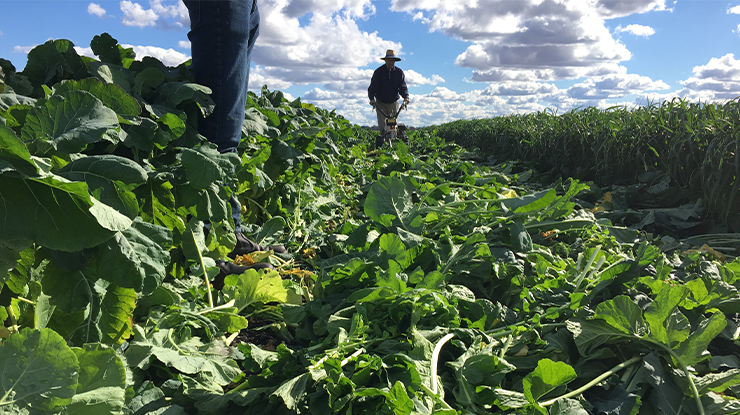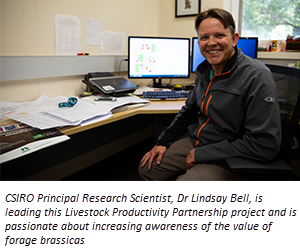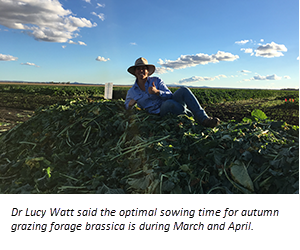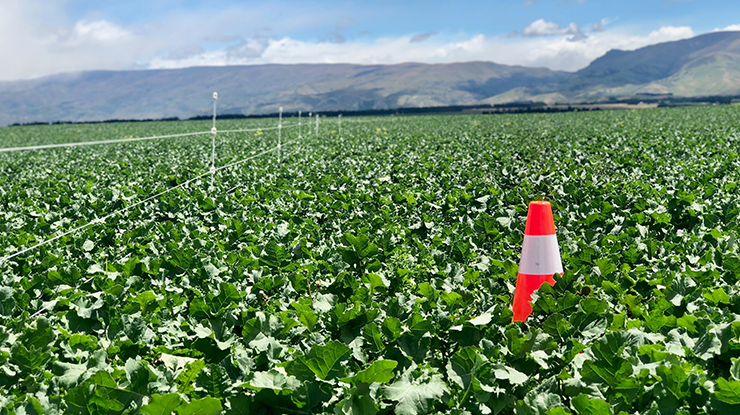 An MLA-supported Livestock Productivity Partnership project is helping to demonstrate the value of forage brassicas in southern grazing systems.
An MLA-supported Livestock Productivity Partnership project is helping to demonstrate the value of forage brassicas in southern grazing systems.
Brassicas bridging the feed gap
Forage brassicas are being put through their paces in an MLA-supported project to help producers fill feed gaps.
In lower-rainfall and sub-tropical mixed farming regions, forage oats are often the fall-back option for filling seasonal feed gaps. However, without robust crop rotation practices, this strategy can lead to longer-term weed and disease pressure.
The Livestock Productivity Partnership (LPP), of which MLA Donor Company (MDC) is a member, is funding a CSIRO-led project to investigate how forage brassicas could be used as a grazing alternative.
Project leader, CSIRO Principal Research Scientist Dr Lindsay Bell, and his colleague Dr Lucy Watt, are comparing the quality and quantity of forage produced by 10 forage brassica genotypes against a standard forage cereal control.

Dr Bell said the research aims to increase producer and advisor awareness of the value of forage brassicas in mixed farming systems across Australia.
Commercially available forage brassicas include forage rape, kale, leafy and bulb turnips, forage radish and raphanobrassica (a kale-radish hybrid).
CSIRO Principal Research Scientist, Dr Lindsay Bell, is leading this Livestock Productivity Partnership project and is passionate about increasing awareness of the value of forage brassicas
“Forage rapes and raphanobrassica have performed most consistently at our trials, which have been carried out in some really tough drought years,” he said.
“In several cases, they produced similar or greater biomass than forage oats and maintained quality for longer, making them a promising alternative.”
|
Are forage brassicas right for you? Producers should consider forage brassicas when:
|
Agronomic considerations

Forage brassicas are suited to a range of soil types of varying fertility.
Leafy varieties have deep root systems which allow them to use subsoil moisture, although crop nutrition is also important.
Dr Watt recommends implementing similar agronomic management to grain or dual-purpose canola.
“Optimal sowing time for autumn grazing is during March and April, but this can be later if spring growth is required.”
Forage brassicas are susceptible to similar pests and diseases as canola. On-farm management, including seed treatment, spraying and trash removal will help to mitigate risks.
Livestock health
Forage brassicas can fill feed gaps in autumn, winter and spring, and can maintain quality better than other options if allowed to accumulate biomass.
“A number of these species can be grazed multiple times and late into the season, which provides greater flexibility in the livestock enterprise,” Dr Bell said.
As with many monoculture forages, there are some animal health risks with grazing forage brassica crops. Animals should be introduced gradually and with a full stomach, and grazing should be avoided after recent nitrogen fertilisation to prevent nitrate poisoning.
“As with any change, it’s advisable to monitor animals regularly for any signs of ill-health,” Dr Watt said.
Economic benefits
Preliminary analysis has shown that by filling feed gaps at critical times of the year, forage brassicas can reduce supplementary feeding or the need for destocking during these periods. This can increase safe stocking rates by 20–40%, depending on the system and location.
“This aspect of our research project is still being investigated further using whole-farm system modelling approaches,” Dr Bell said.
“This will allow us to identify the benefits of forage brassicas in filling existing feed gaps within different regions and livestock production systems.”
“Our research has shown forage brassicas can provide extensive grazing for livestock. For example, over a dry autumn raphanobrassica provided more than 3,000 sheep grazing days compared to forage rape, which provided 1,200 sheep grazing days.”
Other considerations
Dr Watt said the project will help to identify optimal grazing windows based on biomass availability and forage quality.
For example, in New Zealand, traffic cones are currently provided with some forage brassicas (e.g. raphanobrassica) to guide producers to identify optimal plant heights so they know when to start and finish grazing.

Traffic cones being used to indicate optimal grazing height in a New Zealand trial of raphanobrassica. When the plant reaches the top of the cone, it’s ready to graze. A mark at the base of the cone indicates when grazing should end.
“We’ll conduct on-farm demonstration sites this year, where we’ll grow forage brassicas and use these guidelines to test this under real farm conditions,” she said.



